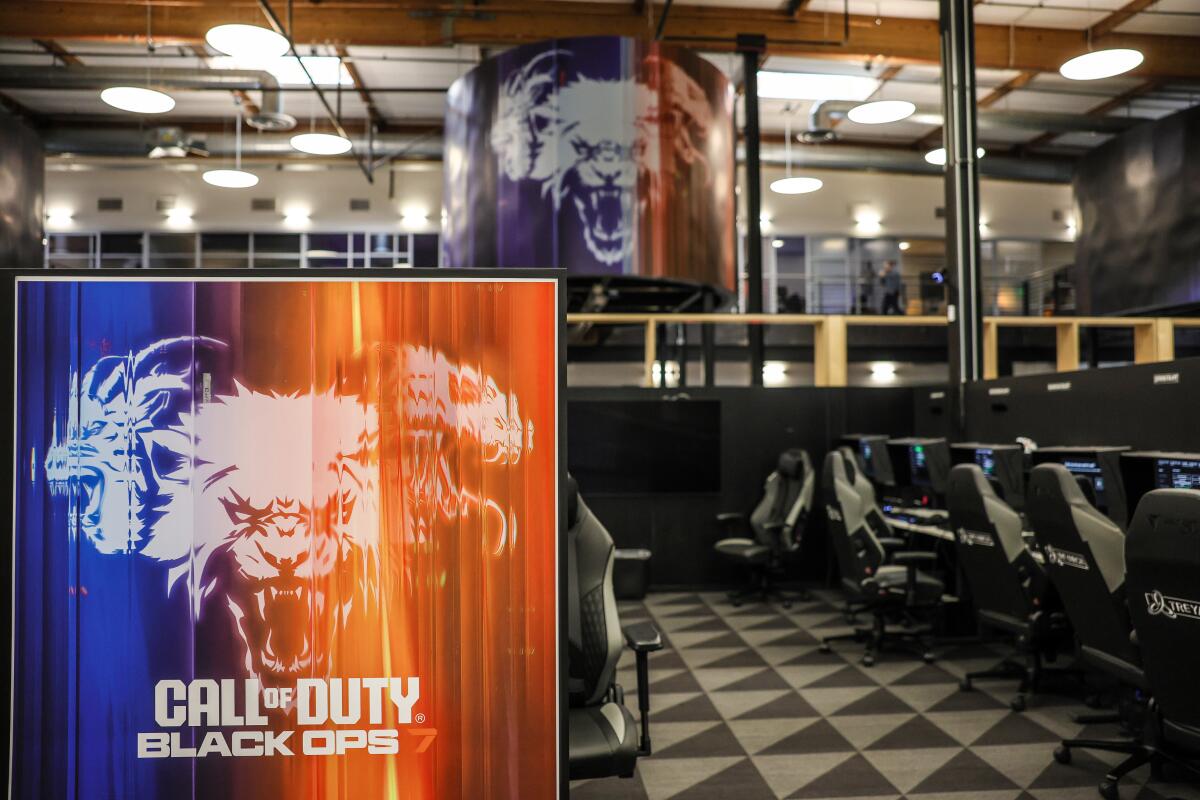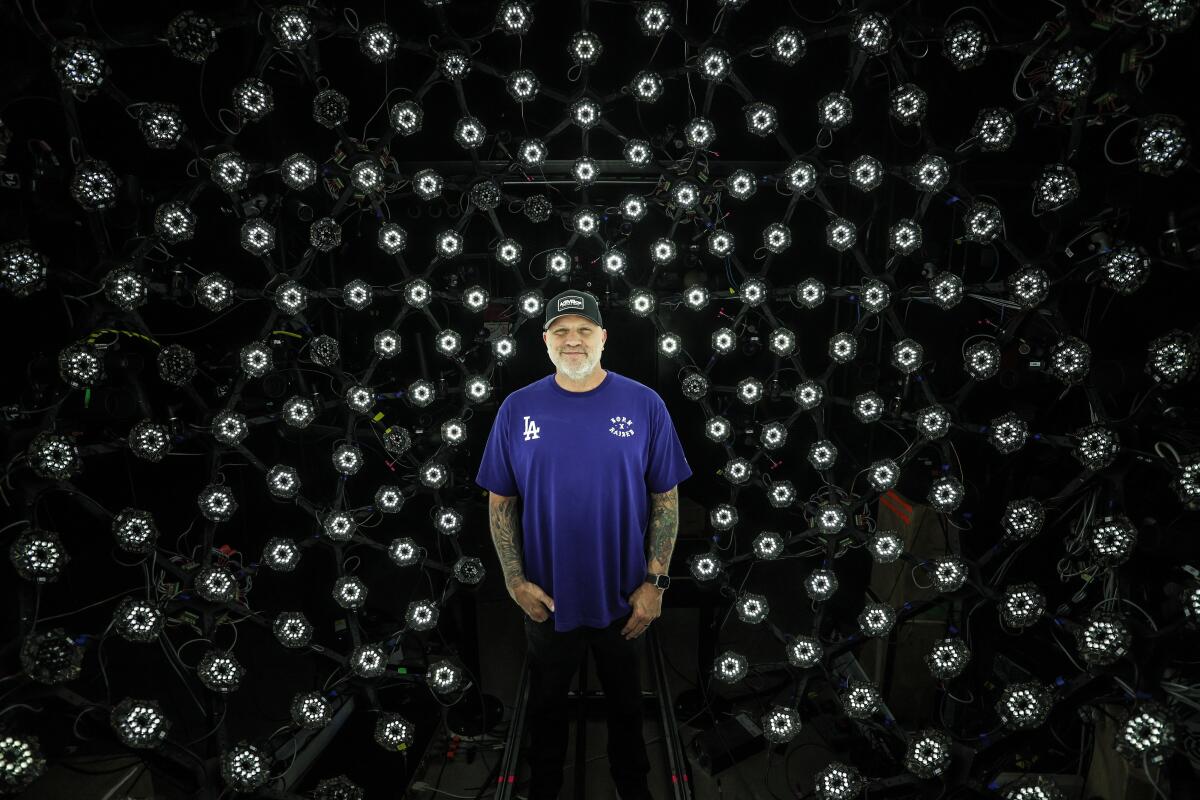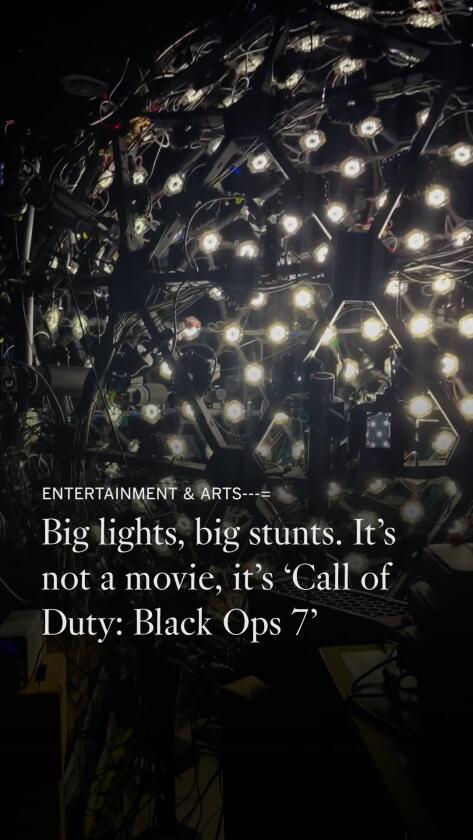Big stars, big stunts. It’s not a movie, it’s ‘Call of Duty: Black Ops 7’
Clad in close-fitting black outfits, two performers get into stance for a fight scene. The cameras surrounding the massive stage in Playa Vista start rolling.
-
Share via
One turns around slowly, pantomimes being shot, and carefully, deliberately, arches himself backward, clawing at the air before a stunt coordinator helps ease him toward a black mattress.
That movement is translated into dots and lines on a nearby computer, transmitted by the round, white sensors embedded in the suits’ colorful almond-shaped patches. Later, those will be fleshed out into characters and scenes in the new “Call of Duty: Black Ops 7” game, which debuts Friday.
It’s all part of the blockbuster production effort that goes into making one of the most popular video game franchises ever. “Call of Duty,” from Santa Monica publisher Activision, has ranked as the top-selling video game series in the U.S. for 16 straight years and has sold more than 500 million copies globally since the first installment was released in 2003.
And as one of the few franchises with an annual release schedule, hitting that deadline takes an army. About 3,000 people worked on “Black Ops 7” over the course of four years.
Activision executives declined to discuss the game’s budget but called it a “significant investment.” Top video game franchises can have production costs of $250 million or more — higher than most big-budget Hollywood films.
“It’s like, every year we have to launch a new ‘Star Wars.’ Every year we have to launch a new ‘Avatar,’ ” said Tyler Bahl, chief marketing officer at Activision. “So we have to think about, how do we do this in an unexpected way?”
“Ultimately, we want to treat our games like an absolute blockbuster,” said Matt Cox, general manager of “Call of Duty” at Activision, who has worked on the franchise for more than 10 years. “The investment is there for them.”

Activision’s Treyarch game production studio is where Call of Duty video game is produced.
(Robert Gauthier / Los Angeles Times)
The franchise has become a key driver of Activision’s success, analysts said.
The base game consistently sells more than 20 million units annually, not including the live services components that update after a game’s launch and keep players engaged, monthly battle passes that unlock rewards or even the mobile game, all of which add up to an estimated annual sales of about $3.5 billion to $4 billion, said Eric Handler, media and entertainment analyst at Roth Capital.
In fact, the huge popularity of “Call of Duty” helped spur tech giant Microsoft’s interest in acquiring Activision, a $69-billion deal that was completed in 2023.
“It revolutionized the first-person shooter and has done a great job, year in and year out, of being the best of breed, building the largest community and evolving, pivoting to where video game players are all over the world,” Handler said. “There are other [shooter] franchises that are trying to replicate its success … but nobody’s been able to match the consistency of ‘Call of Duty.’”
To maintain its annual cadence, Activision rotates game development among several of its studios, including Playa Vista-based Treyarch, which co-developed “Black Ops 6” and “Black Ops 7” in parallel — the first time that two “Call of Duty: Black Ops” games came out in subsequent years.
The previous game is set in the ‘90s, while the newest installment jumps ahead to 2035, meaning designers and animators had to envision what gear and gadgets might look like in the future (“Call of Duty: Black Ops 2” was eerily accurate in its predictions for the year 2025).
“It was a huge opportunity for us to tell two unique but also connected stories at the same time,” said Yale Miller, senior director of production at Treyarch.
Unlike the linear nature of film production, many things happen in tandem when producing a game like “Call of Duty.” The game has a campaign mode that follows a story, a multiplayer option to play with friends and the ever-popular zombies portion, meaning each designated team is thinking in parallel about things like tone, features and playable moments that they want fans to experience, Miller said.
While an actor is recording lines, another team may be building the weapon they mention and making it interactive, while another group builds the explosion that the lines and weapon will be part of.
“It’s not just, ‘Oh, we got the shot. We’re done for the day,’ ” Miller said. The acting performance is “an anchor for a lot of the things that we build, but then it’s the whole world in parallel, and that’s how we get to such big teams working on stuff, and everything has to get thought about.”
The franchise has become known for its intense, cinematic quality, a reputation enhanced by the live-action film and television backgrounds of many who work on the games, including some stunt performers and Treyarch performance capture director Mikal Vega, who worked on the 2017 NBC drama “The Brave” after a long career in the military.
“It’s theater-in-the-round,” he said during a Zoom call from the stage. “A lot more like theater-in-the-round than film in some cases, and very much like film in other phases of it.”
And there is a bit of a learning curve, particularly because of the motion-capture technology used, which can make movements awkward.
In the new game, “This Is Us” star Milo Ventimiglia plays Lt. Cmdr. David Mason, a character who first appeared in 2012’s “Call of Duty: Black Ops 2” and is now on the hunt for a former arms dealer who caused the death of his father and was previously believed dead.
Acting in “Black Ops 7” was “more technical” than his previous film and TV roles since it required getting used to a boom mic or camera that jutted out in front of him, he said. In one early instance, Ventimiglia went to scratch an itch on his cheek and was told by the crew not to put anything between his face and the camera, and to pantomime scratching outside of the camera, not realizing it wasn’t acting.
Then there were four-hour sessions in the sound booth, saying lines dozens of times in dozens of ways with any number of weapons.
“It’s super, super taxing, hard work, but fun at the same time,” Ventimiglia said. “When are you going to talk about calling out grenades and flash bangs and using different weapons? Very rarely.”
Adding to the cinematic quality are the hyper-realistic portrayals of actors, gear and costumes, which are the result of scans on a light stage that can re-create items in 3-D. Principal and background characters sit on a chair inside the sphere and do poses, surrounded by 16 DSLR cameras and dozens of hexagonal lights that emit a hazy glow. In 1.3 seconds, more than 256 images will be shot. Principal characters like Ventimiglia will typically do up to 120 poses — all to make sure the nuances of someone’s face are captured.

Evan Buttons, Activision director of technical projects, is photographed inside the face scanning studio.
(Robert Gauthier / Los Angeles Times)
In a nearby room with a 22-foot ceiling and black, soundproof walls, an even larger sphere with more than 140 cameras and several video cameras are used to capture full body scans, gear and costumes. Everything captured then goes to the character art team, which will tweak it to their specifications and put it in the game.
Even in the days leading up to the game’s release, the team was still busy. In an era when internet speeds are faster, work doesn’t end with a game’s initial release. Content will be released regularly in the months after “Black Ops 7” debuts, all to keep it fresh for players, who can put more than 1,000 hours into the game.
“The No. 1 reason why they play ‘Call of Duty’ is actually because their friends are there,” said Bahl of Activision. “Those bonds and those social connections, I think, is really what makes this game different and stronger, and it’s made it last for so long.”

